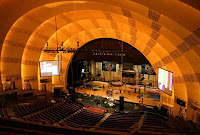The Radio City Music Hall is a great example of an all around satisfying building. The design of the building is very pleasing, in fact so pleasing and delightful it inspired the design of other buildings such as the Apollo Theatre. The building has been open to the public since December 27, 1932, being around that long and not needing much renovation to do so would inquire that the structure of this being is very firm and concrete. Last but not least it serves it’s full commodity due to having more than 300 million people come to the Music Hall to enjoy stage shows, movies, concerts and special events, and also being the largest indoor theatre in the world.
[2] Working from Harwood et al’s concept of cultural precedents, select one of the contemporary textiles illustrated above and PINPOINT the influences you see from the eastern world on the production of fabric in the west. Concentrate on motifs and patterns provided in Harwood’s text (5 points).
This textile design looks to be inspired by oriental culture. According to Harwood "The Chinese employ numerous motifs, many symbolic, used alone or in combinations. Common motifs for architecture, interiors, furnishings, and decorative arts are lions, dragons, the phoenix, fret, the lotus (purity), clouds, fruits, chrysanthemums, the shou (long life), and caligraphy." The flowers shown in the image look to be chrysanthemums, which consists of about 30 species of flowers and are as listed above a common motif of oriental culture.
[3] When considering perceptions of personal and social space, Hall and others suggest that different cultures have different space needs and attitudes. Most consider that citizens of the U.S. generally feel a need for more space. How does this play out in the classroom in which we gather for iar222? (5 points)
I concentrate better and feel more comfortable when I have a decent amount of space especially while taking notes, taking a test, or just attending class in general. The Auditorium we meet in as well as the majority of school auditoriums I’ve been in all seem very tight. In order to get in or out of a seat in the middle of the aisle you have to squeeze through the tight aisle, which is already tight and hard to travel through without fellow students occupying the seats, knocking people’s papers off their desk and stepping on their feet. Relating more to Hall I would say that the typical U.S. citizen would often request more space due to being spoiled (at least the majority) from U.S. culture, which depicts the finer things in life or "the american dream."
[4] SPECULATE about whether or not there can be an architecture of happiness, as de Botton writes in the work by the same title. Provide a juicy quote that helps give evidence to your views from the passage that you read. Include an annotated image of a happy object, space, building, or place and specify WHY and HOW your example exudes happiness (5 points)
“In the living room of a house in the Czech Republic, we see an example of how walls, chairs and floors can combine to create an atmosphere in which the best sides of us are offered the opportunity to flourish.”- Alain de Botton
Many people decorate through personality allowing uniqueness among the majority. Architecture, as well as any other art form or invention, would be dull and boring if personality wasn't involved. Even though standards are set such as building codes, there is almost an unlimited amount of room for self-expression as long as those standards are met within the design. Architects, being the masters at taking advantage of self-expression tend to often form an image of their personality upon their designs making them unique therefore making it easier to identify individual designers.



